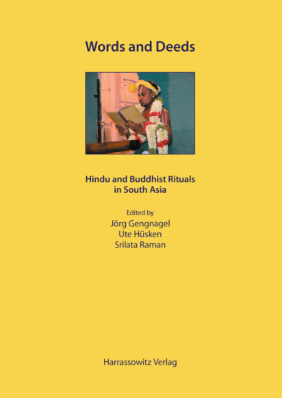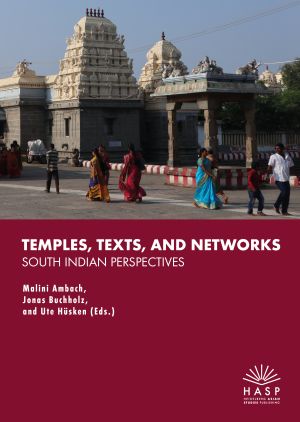Hüsken, Ute
Die Vorschriften für die buddhistische Nonnengemeinde im Vinaya-Piṭaka der Theravādin
Wohl gegen Ende des ersten nachchristlichen Jahrtausends endete die Ordinationstradition der Nonnen der buddhistischen Theravāda-Schule. Dennoch werden auch die Verhaltensvorschriften der Nonnen, die ebenso wie die der Mönche als Buddhawort gelten, in der Sammlung der kanonischen Texte weiterhin überliefert. In der vorliegenden Untersuchung wird das Regelkonvolut für Nonnen der Theravāda-Tradition ausgehend von den besonderen Nonnenregeln im Buch der Ordensdisziplin (Vinaya-Piṭaka) und den relevanten Kommentarstellen in der Samantapāsādikā dargestellt und mit den Verhaltensvorschriften für die Mönche derselben Überlieferung verglichen. Die Arbeit ist eine überarbeitete Fassung der 1995 vom Fachbereich Historisch-Philologische Wissenschaften der Georg-August-Universität in Göttingen angenommenen Dissertation.
Viṣṇu's Children: Prenatal life-cycle rituals in South India
The Vaikhānasas, a group of Brahmanic priests in the Viṣṇu temples of south India, can look back on a long and turbulent history, that is characterized by the effort of claiming their status against rivalling priests. Central to this monograph is a controversy, ongoing for centuries, as to what makes a person eligible to perform the rituals in Viṣṇu temples: does birth or an initiation create the ideal intermediary between the god and humans? Since the 14th century CE the discussions in the relevant Sanskrit texs centre around the question of whether the Vaikhānasas priests must undergo an initiation including a branding on the upper arms, or whether their particular prenatal life-cycle ritual viṣṇubali makes them eligible to perform temple ritual. As hereditary temple priests the Vaikhānasas’ own stance is explicit: they are Viṣṇu’s own children, preordained for temple service already before birth. In addition to the textual perspective, three instances of local conflicts from the 19th/20th centuries about the question of whether the Vaikhānasas require an initiation are analysed in their contexts. Furthermore, three examples of present-day performances of the viṣṇubali ritual are presented and interpreted in the light of the relation between text and performance.
The films, which were originally published on a DVD accompanying the book, are archived in the heidICON multimedia database and can be viewed via the following links:
- Introduction (length 08:10 min)
- Full ritual (length 28:28 min)
- Prepatory rites - Formal declaration (03:51 min)
- Prepatory rites - Vitalisation of the sacrificial fire (06:45)
- Main offerings - Pūjā for Viṣṇu's twelve forms (11:09 min)
- Main offerings - Offering into the fire (09:01 min)
- Main offerings - Viṣṇu marks the unborn child (09:53 min)
- Atonement for ritual flaws (03:46 min)
- Concluding rites (04:43)
- Credits
Words and Deeds: Hindu and Buddhist Rituals in South Asia
Words and Deeds is a collection of articles on rituals in South Asia with a special focus on their texts and context. The volume presupposes that a comprehensive definition of “ritual” does not exist. Instead, the papers in it avoid essentialist definitions, allowing for a possible polythetic definition of the concept to emerge. Papers in this volume include those on Initiation, Pre-Natal Rites, Religious Processions, Royal Consecration, Rituals which mark the commencement of ritual, Rituals of devotion and Vedic sacrifice as well as contributions which address the broader theoretical issues of engaging in the study of ritual texts and ritual practice, both from the etic and the emic perspective. These studies show that any study of the relationship between the text and the context of rituals must also allow for the possibility that different categories of performers can and do subjectively constitute the relationship between their ritual knowledge and ritual practice, between text and context in differing and nuanced ways.
Temples, Texts, and Networks: South Indian Perspectives
For many centuries, Hindu temples and shrines have been of great importance to South Indian religious, social and political life. Aside from being places of worship, they are also pilgrimage destinations, centres of learning, political hotspots, and foci of economic activities. In these temples, not only the human and the divine interact, but they are also meeting places of different members of the communities, be they local or coming from afar. Hindu temples do not exist in isolation, but stand in multiple relationships to other temples and sacred sites. They relate to each other in terms of architecture, ritual, or mythology, or on a conceptual level when particular sites are grouped together. Especially in urban centres, multiple temples representing different religious traditions may coexist within a shared sacred space. The current volume pays close attention to the connections between individual Hindu temples and the affiliated communities, be it within a particular place or on a trans-local level. These connections are described as “temple networks,” a concept which instead of stable hierarchies and structures looks at nodal, multi-centred, and fluid systems, in which the connections in numerous fields of interaction are understood as dynamic processes.
Reviews
Amol Saghar in: IIAS Reviews (2023)











